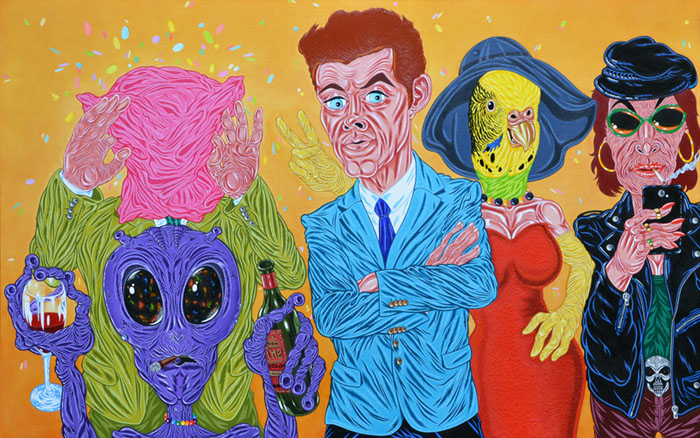 home
about
artists
exhibitions press
contact
purchase
home
about
artists
exhibitions press
contact
purchase |
|
|
3 February - 1 March 2014 |
|
|
|
Peter Henryk Blum 'Fresh German Realism' Peter Henryk Blum is one of the most exciting German figurative artists of his generation. Using the Old Masters techniques of layer and glaze painting, his scenes are muted, selective with colour, like silent film reels and tinted sepia prints. Players are staged in ironically self-conscious poses where the melancholia of sad harlequins and heavily made up women is reminiscent of physical theatre. Light hearted or darkly surreal, the works are unsettling because it is clear these people are not alone in their secret rituals. Gentle diffusions of light are met by the devilishly sharp details of technical brilliance. The unreality of the real world with its desires, alienation, loneliness and illusion is presented in a deeply lyrical style as Blum steers us away from the rational subjective self into the strength of the collective. The characters are heartbreakingly earnest in their wordless attempts to communicate and these pantomimes verge on the Theatre of the Absurd, much like the Orator’s indecipherable speaker in Ionesco’s play The Chairs. The meta-theatricality of Blum’s work confronts us with the contradictions of humanity. Wearing dark glasses, we long to hide away but to also be adored, to ‘know fully, even as we are fully known’. Blum’s staging of each character remains strange because it is clear they are not alone in their secret rituals. Struck dumb, there is always someone watching in the wings- and that person turns out to be you. |
|
|
Oliver Estavillo 'Comédie
Humaine' Oliver Estavillo has been referred to as "Pop-Brueghel" and "The Tarantino of Painting". His inspiration is taken from everyday life; the bizarre neighbours, serial killers, boring aunts and shrill parties. Like Ripley’s Believe it or Not, Estavillo’s oils are circuses of weird and wonderful creatures. Ladies with budgerigar heads and droopy hats wear their pearls high to disguise crepey necks and sagging jowls. They gaze out of colourless eyes under dusty chandeliers and bare bulbs highlighting very possible crease and fold as though they were deflating behind the settee like old balloons forgotten after a party.. These operatic gatherings are peopled with muscle men with squared hair and tanned torsos, sinewy women in tight cocktail dresses, tentacle-headed lurkers and emperors in need of new clothes. Estavillo’s work reminds us of the transient nature of life, and that the material world is meaningless. Unlike many moralistic paintings where the sensuality of the painting undermines the main message of aesthetic futility, these works are disturbing and explicitly morbid. These are places where the meat-mottled women drink wine and fanged stags brawl under neatly mounted taxidermy testicles. The raw sexuality and animalistic debauchery makes these much more of an Angela Carter take on your average fairytale. From Holbein to Bernt Notke, the certainty of death has been explored throughout history, particularly through the ‘Danse Macabre’. Estavillo’s Puce-faced devils, confetti and baboon-clowns demonstrate life’s madness, vulgarity and unlimited greed. This ultra-violent fantasism scratches beneath the glittering surface to expose decay, confronting us with our own selfish bloodlust. |
| The exhibition is held alongside a sculpture collection which features works by Eleanor Cardozo, Nicola Godden, Richard L.Minns, Andy Cheese, Jamie McCartney, Ian Edwards, Gianfranco Meggiato and Palolo Valdes. | |
|
|
E-mail: info@hayhillgallery.com |

